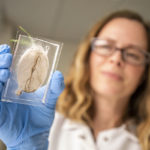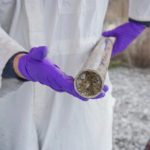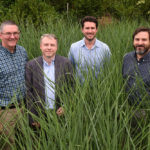Berkeley Lab geneticist Len Pennacchio and his team helped a group of Israeli clinical researchers solve the mystery of a rare inherited disease that causes extreme, sometimes fatal, chronic diarrhea in children. The nearly decade-long investigation not only led to the discovery of a novel protein-coding gene that is critical for intestinal function, but also expanded our understanding of regulatory sequences in the human genome. The results were recently published in Nature.
JGI Helps Determine Archaeal Symbiotic Lifestyles
Symbiotic relationships are long-term biological interactions between one or more biological organisms. Nanohaloarchaea are part of the DPANN superphylum of extremophilic archaea first outlined by JGI scientists and their collaborators in 2013. While most DPANN lineages are predicted symbionts, the Nanohaloarchaeota were predicted to be capable of autonomous growth because they had larger genome sizes and their cells were not observed to associate with host cells.
In the Proceedings of the National Academy of Sciences, a team led by Rick Cavicchioli at the University of New South Wales along with researchers at the Joint Genome Institute (JGI) experimentally demonstrated that Nanohaloarchaeota are not free-living archaea but rather symbionts. Click here to read the JGI science highlight.
EcoFABs: Fabricated Microbial Ecosystem Models to Advance Microbiome Research
Biosciences’ Trent Northen and Ben Brown, along with collaborators from more than a dozen institutions, co-authored a paper published in Nature Methods that outlines a vision for fabricated model microbial ecosystems (EcoFABs) and their potential impact on microbiome science.
Scientists Hit Pay Dirt with New Microbial Research Technique
In a Nature Communications report, a team of Berkeley Lab Biosciences Area scientists detail the first-ever successful use of a technique called BONCAT to isolate active microbes present in a sample of soil. Working within a Berkeley Lab-led scientific focus area called ENIGMA (for Ecosystems and Networks Integrated with Genes and Molecular Assemblies), Trent Northen’s lab in the Environmental Genomics and Systems Biology (EGSB) division teamed with JGI researchers on the work.
JGI Helps Study Local Adaptation in Switchgrass
The perennial grass switchgrass (Panicum virgatum) is a candidate bioenergy feedstock, with deep roots that allow it to access nutrients easily from a variety of soils and a higher tolerance for extreme water conditions. To better understand the genetic basis of local adaptation, researchers established community gardens of switchgrass plants in 10 different field sites on a north-south gradient across the United States. Early results reported in the Proceedings of the National Academy of Sciences from these large-scale field tests conducted over two years reveal fewer tradeoffs in plant fitness and adaptation than expected. Click here to read the full science highlight on the JGI website.
- « Previous Page
- 1
- …
- 22
- 23
- 24
- 25
- 26
- …
- 46
- Next Page »
Was this page useful?








